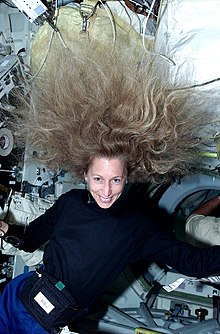
Back آثار رحلة الفضاء على جسم الإنسان Arabic Efecte del vol espacial en el cos humà Catalan Efectos del viaje espacial en el cuerpo humano Spanish Kosmoselennu mõju inimesele Estonian اثر پرواز فضایی بر بدن انسان Persian Adaptation humaine à l'espace French Adaptação humana ao voo espacial Portuguese Efectele zborului spațial asupra corpului uman Romanian Uzay uçuşunun insan vücudu üzerindeki etkisi Turkish Вплив космічного польоту на людське тіло Ukrainian

The effects of spaceflight on the human body are complex and largely harmful over both short and long term.[1] Significant adverse effects of long-term weightlessness include muscle atrophy and deterioration of the skeleton (spaceflight osteopenia).[2] Other significant effects include a slowing of cardiovascular system functions, decreased production of red blood cells (space anemia),[3] balance disorders, eyesight disorders and changes in the immune system.[4] Additional symptoms include fluid redistribution (causing the "moon-face" appearance typical in pictures of astronauts experiencing weightlessness),[5][6] loss of body mass, nasal congestion, sleep disturbance, and excess flatulence. Overall, NASA refers to the various deleterious effects of spaceflight on the human body by the acronym RIDGE (i.e., "space radiation, isolation and confinement, distance from Earth, gravity fields, and hostile and closed environments").[3]
The engineering problems associated with leaving Earth and developing space propulsion systems have been examined for over a century, and millions of hours of research have been spent on them. In recent years, there has been an increase in research on the issue of how humans can survive and work in space for extended and possibly indefinite periods of time. This question requires input from the physical and biological sciences and has now become the greatest challenge (other than funding) facing human space exploration. A fundamental step in overcoming this challenge is trying to understand the effects and impact of long-term space travel on the human body.
In October 2015, the NASA Office of Inspector General issued a health hazards report related to space exploration, including a human mission to Mars.[7][8]
On 12 April 2019, NASA reported medical results from the Astronaut Twin Study, where one astronaut twin spent a year in space on the International Space Station, while the other spent the year on Earth, which demonstrated several long-lasting changes, including those related to alterations in DNA and cognition, after the twins were compared.[9][10]
In November 2019, researchers reported that astronauts experienced serious blood flow and clot problems while on board the International Space Station, based on a six-month study of 11 healthy astronauts. The results may influence long-term spaceflight, including a mission to the planet Mars, according to the researchers.[11][12]
- ^ Chang, Kenneth (27 January 2014). "Beings Not Made for Space". The New York Times. Retrieved 27 January 2014.
- ^ Kanas, Nick; Manzey, Dietrich (2008). "Basic Issues of Human Adaptation to Space Flight". Space Psychology and Psychiatry. Space Technology Library. Vol. 22. pp. 15–48. Bibcode:2008spp..book.....K. doi:10.1007/978-1-4020-6770-9_2. ISBN 978-1-4020-6769-3.
- ^ a b Johnson, Doug (14 January 2022). "We don't know why, but being in space causes us to destroy our blood - Space anemia is tied to being in the void and can stick around awhile". Ars Technica. Retrieved 14 January 2022.
- ^ Neergard, Lauran; Birenstein, Seth (15 February 2019). "Year in space put US astronaut's disease defenses on alert". Associated Press. Retrieved 18 February 2019.
- ^ "Health and Fitness". Space Future. Archived from the original on 2017-12-13. Retrieved 2012-05-10.
- ^ Toyohiro Akiyama (April 14, 1993). "The Pleasure of Spaceflight". Journal of Space Technology and Science. 9 (1): 21–23. Archived from the original on 2017-11-17. Retrieved 2012-05-10.
- ^ Dunn, Marcia (October 29, 2015). "Report: NASA needs better handle on health hazards for Mars". Associated Press. Archived from the original on 2019-03-10. Retrieved October 30, 2015.
- ^ Staff (October 29, 2015). "NASA's Efforts to Manage Health and Human Performance Risks for Space Exploration (IG-16-003)" (PDF). NASA. Retrieved October 29, 2015.
- ^ Zimmer, Carl (12 April 2019). "Scott Kelly Spent a Year in Orbit. His Body Is Not Quite the Same". The New York Times. Retrieved 12 April 2019.
- ^ Garrett-Bakeman, Francine E.; et al. (12 April 2019). "The NASA Twins Study: A multidimensional analysis of a year-long human spaceflight". Science. 364 (6436): eaau8650. Bibcode:2019Sci...364.8650G. doi:10.1126/science.aau8650. PMC 7580864. PMID 30975860.
- ^ Strickland, Ashley (15 November 2019). "Astronauts experienced reverse blood flow and blood clots on the space station, study says". CNN News. Retrieved 16 November 2019.
- ^ Marshall-Goebel, Karina; et al. (13 November 2019). "Assessment of Jugular Venous Blood Flow Stasis and Thrombosis During Spaceflight". JAMA Network Open. 2 (11): e1915011. doi:10.1001/jamanetworkopen.2019.15011. PMC 6902784. PMID 31722025.
© MMXXIII Rich X Search. We shall prevail. All rights reserved. Rich X Search